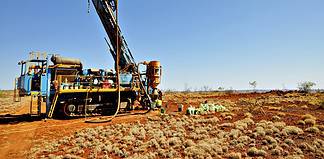SALT Lake Potash has begun construction on the country’s first commercial scale on-lake Sulphate of Potash (SOP) evaporation ponds.
The ASX-listed company, along with about half a dozen other groups, is seeking to pioneer the production of SOP from Western Australian salt lakes.
It has received approval from the WA Department of Water and Environmental Regulation, clearing the way for construction of the initial Lake Way Ponds near the northern goldfields town of Wiluna to begin, as well as the dewatering of the Williamson Pit.
The lake is one of nine in the portfolio of lakes owned by the company, which aims to establish a highly profitable, globally significant fertiliser business in which sustainability is treated as an absolute priority.
The company plans to extract hypersaline brine from across the salt lakes in the area to produce potassium-rich harvest salts, which are then converted to SOP for the domestic and international markets.
SOP is valued by farmers for its high potassium and very low chloride content, which boosts flower and fruit development. The macro-nutrient also helps to ripen and strengthen plants, ensuring they can defend against pest, disease and weather damage.
The initial Lake Way ponds will have a volume of 1.8 gigalitres, sufficient to capture the total measured brine resource in the nearby Williamson pit of 1.2 gigalitres at 25kg/m3 SOP equivalent.
This equates to 32,000 tonnes equivalent of premium SOP and represents only a small portion of the Lake Way mineral resource estimate, the highest-grade brine resource in Australia.
And this is just the start. Extensive exploration activity is also underway across the whole region as the company seeks to optimise the project’s significant resource potential.
Each of the lakes have been selected based on potential brine volume, known hypersaline brine characteristics and the potential for production from shallow trenches or deeper paleochannel aquifer bores.
The initial lakes the company is targeting for production and exploration are close to established transport and project support infrastructure, which will be important in minimising operating costs.
Salt Lake Potash managing director Tony Swiericzuk said the building of the ponds was a key milestone not only for the company, but also for the creation of the new SOP industry within Australia.
“It is extremely exciting to be part of what is shaping as a major new industry for Australia, and one that is a little different to more traditional forms of mining that we are familiar with,” he said.
“Essentially, we will be harnessing the abundant Australian sun as a renewable energy source to produce a premium fertiliser that will help feed the world’s growing population.”
Mr Swiericzuk said although there was no firm date yet for full scale output to begin, Salt Lake Potash was well placed to be one of the first Australian SOP companies to reach commercial production.
“But there is scope for multiple successful players, and that is what we hope to see,” he said.
“The brine evaporation process that the Australian companies are promoting is lower cost and more environmentally friendly than the Mannheim Process, which currently accounts for more than 50pc of global SOP production.”
Indeed, Salt Lake Potash is already working alongside a competitor to share infrastructure and other costs in the region.
As Salt Lake Potash and Australian Potash own neighbouring projects at Lake Wells, one of the Lakes in the portfolio, and therefore share many common infrastructure elements, Mr Swiericzuk said it made sense to explore the potential for sharing development costs.
The company believes that the prospect of significant capital and operating cost savings from sharing infrastructure, and potentially evaporation and salt processing facilities, is ample motivation for pursuing the MoU and cooperation agreement.
While the building of a 50,000tpa demonstration plant is the initial focus,, Salt Lake Potash is now considering larger commercial scale production scenarios following a recent whole-of-lake mineral resource estimate.
“The most recent resource update delivered for Lake Way in mid-March estimated a resource for the whole of the lake for the first time,” Mr Swiericzuk said.
“At 73 million tonnes of SOP, the resource is a significant size and very high grade and supports our view that Lake Way has the potential to sustain a larger scale production scenario than originally envisaged.
“We anticipate releasing the technical results of our review into a larger scale production scenario towards the end of this quarter.”
SOP quantities that cannot be absorbed locally will be targeted to premium markets abroad that provide the most optimal commercial outcomes for company shareholders.
Mr Swiericzuk said there was currently a strong domestic market for SOP of about 100ktpa.
“We are looking to work with local farmers and distributors to see how Salt Lake Potash can feed into this market,” he said.
In other good news for the industry, the WA State Government recently announced a new class of mining lease for brine minerals, with a significantly reduced rental rate.
The initiative means potash companies will pay $2.32 per hectare for the first five years from the grant of a mining lease and $4.64 per hectare thereafter, down from $18.70 per hectare previously.
“We are continuing to engage with state and federal governments in regards to other areas in which they may be able to assist in promoting the development of the industry,” Mr Swiericzuk said.
“The SOP projects slated for WA not only represent another source of export revenue, royalties and taxes, but will offer a vast number of opportunities for those people living in the regional areas where they are located.”












































